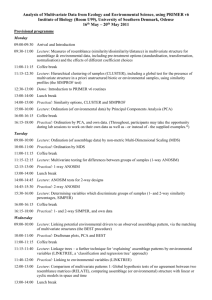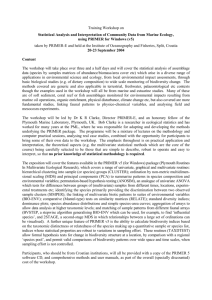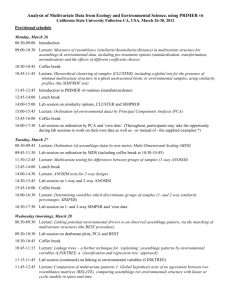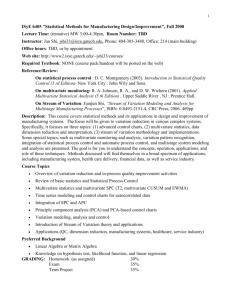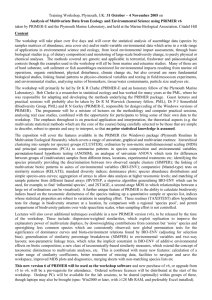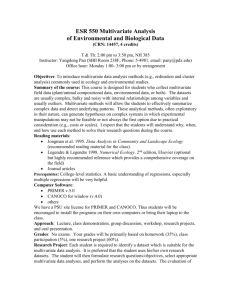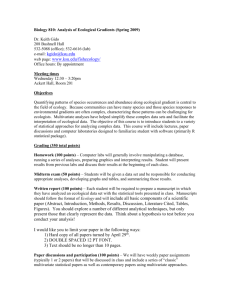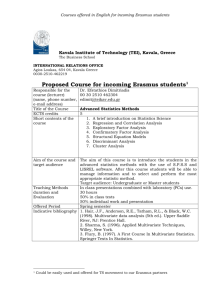Workshop Agenda - San Francisco Bay National Estuarine
advertisement
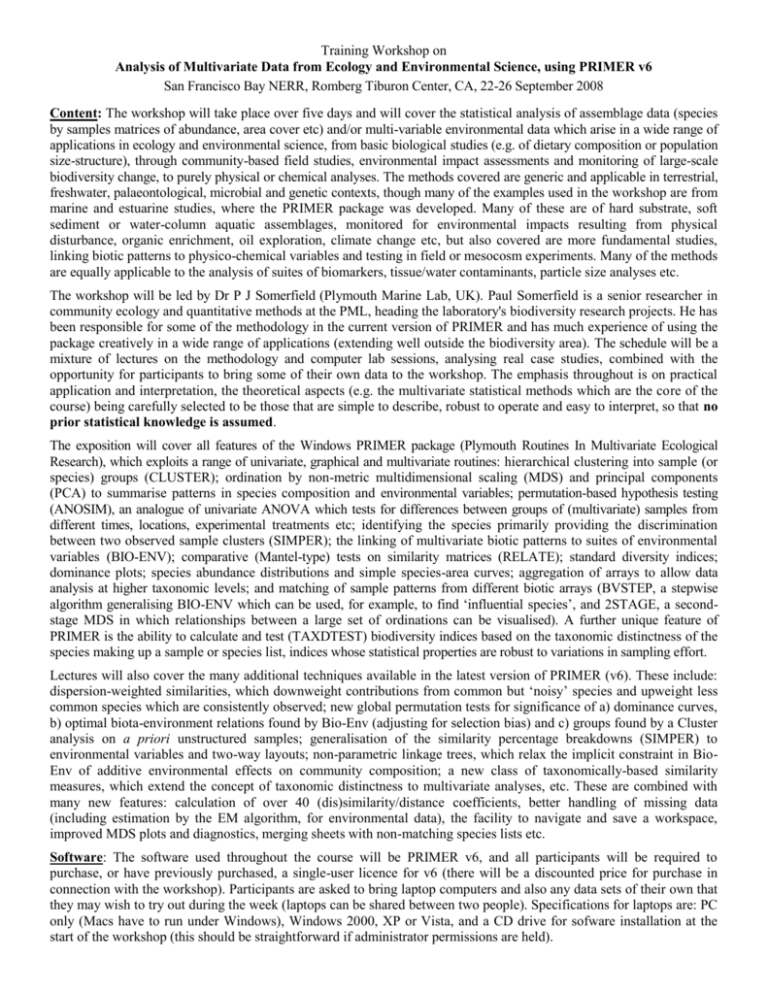
Training Workshop on Analysis of Multivariate Data from Ecology and Environmental Science, using PRIMER v6 San Francisco Bay NERR, Romberg Tiburon Center, CA, 22-26 September 2008 Content: The workshop will take place over five days and will cover the statistical analysis of assemblage data (species by samples matrices of abundance, area cover etc) and/or multi-variable environmental data which arise in a wide range of applications in ecology and environmental science, from basic biological studies (e.g. of dietary composition or population size-structure), through community-based field studies, environmental impact assessments and monitoring of large-scale biodiversity change, to purely physical or chemical analyses. The methods covered are generic and applicable in terrestrial, freshwater, palaeontological, microbial and genetic contexts, though many of the examples used in the workshop are from marine and estuarine studies, where the PRIMER package was developed. Many of these are of hard substrate, soft sediment or water-column aquatic assemblages, monitored for environmental impacts resulting from physical disturbance, organic enrichment, oil exploration, climate change etc, but also covered are more fundamental studies, linking biotic patterns to physico-chemical variables and testing in field or mesocosm experiments. Many of the methods are equally applicable to the analysis of suites of biomarkers, tissue/water contaminants, particle size analyses etc. The workshop will be led by Dr P J Somerfield (Plymouth Marine Lab, UK). Paul Somerfield is a senior researcher in community ecology and quantitative methods at the PML, heading the laboratory's biodiversity research projects. He has been responsible for some of the methodology in the current version of PRIMER and has much experience of using the package creatively in a wide range of applications (extending well outside the biodiversity area). The schedule will be a mixture of lectures on the methodology and computer lab sessions, analysing real case studies, combined with the opportunity for participants to bring some of their own data to the workshop. The emphasis throughout is on practical application and interpretation, the theoretical aspects (e.g. the multivariate statistical methods which are the core of the course) being carefully selected to be those that are simple to describe, robust to operate and easy to interpret, so that no prior statistical knowledge is assumed. The exposition will cover all features of the Windows PRIMER package (Plymouth Routines In Multivariate Ecological Research), which exploits a range of univariate, graphical and multivariate routines: hierarchical clustering into sample (or species) groups (CLUSTER); ordination by non-metric multidimensional scaling (MDS) and principal components (PCA) to summarise patterns in species composition and environmental variables; permutation-based hypothesis testing (ANOSIM), an analogue of univariate ANOVA which tests for differences between groups of (multivariate) samples from different times, locations, experimental treatments etc; identifying the species primarily providing the discrimination between two observed sample clusters (SIMPER); the linking of multivariate biotic patterns to suites of environmental variables (BIO-ENV); comparative (Mantel-type) tests on similarity matrices (RELATE); standard diversity indices; dominance plots; species abundance distributions and simple species-area curves; aggregation of arrays to allow data analysis at higher taxonomic levels; and matching of sample patterns from different biotic arrays (BVSTEP, a stepwise algorithm generalising BIO-ENV which can be used, for example, to find ‘influential species’, and 2STAGE, a secondstage MDS in which relationships between a large set of ordinations can be visualised). A further unique feature of PRIMER is the ability to calculate and test (TAXDTEST) biodiversity indices based on the taxonomic distinctness of the species making up a sample or species list, indices whose statistical properties are robust to variations in sampling effort. Lectures will also cover the many additional techniques available in the latest version of PRIMER (v6). These include: dispersion-weighted similarities, which downweight contributions from common but ‘noisy’ species and upweight less common species which are consistently observed; new global permutation tests for significance of a) dominance curves, b) optimal biota-environment relations found by Bio-Env (adjusting for selection bias) and c) groups found by a Cluster analysis on a priori unstructured samples; generalisation of the similarity percentage breakdowns (SIMPER) to environmental variables and two-way layouts; non-parametric linkage trees, which relax the implicit constraint in BioEnv of additive environmental effects on community composition; a new class of taxonomically-based similarity measures, which extend the concept of taxonomic distinctness to multivariate analyses, etc. These are combined with many new features: calculation of over 40 (dis)similarity/distance coefficients, better handling of missing data (including estimation by the EM algorithm, for environmental data), the facility to navigate and save a workspace, improved MDS plots and diagnostics, merging sheets with non-matching species lists etc. Software: The software used throughout the course will be PRIMER v6, and all participants will be required to purchase, or have previously purchased, a single-user licence for v6 (there will be a discounted price for purchase in connection with the workshop). Participants are asked to bring laptop computers and also any data sets of their own that they may wish to try out during the week (laptops can be shared between two people). Specifications for laptops are: PC only (Macs have to run under Windows), Windows 2000, XP or Vista, and a CD drive for sofware installation at the start of the workshop (this should be straightforward if administrator permissions are held). Analysis of Multivariate Data from Ecology and Environmental Science, using PRIMER v6 San Francisco Bay NERR, Romberg Tiburon Center, CA, 22-26 September 2008 Provisional Schedule Monday, September 22 08:30-08:45 Introduction 08:45-10:45 Lecture: Measures of resemblance (similarity/dissimilarity/distance) in multivariate structure for assemblage & environmental data, including pre-treatment options (standardisation, transformation, normalisation) and the effects of different coefficient choices 10:45-11:00 Coffee break 11:00-11:45 Lecture: Hierarchical clustering of samples (CLUSTER) 11:45-12:45 Introduction to PRIMER v6 routines (installation/demo) 12:45-14:00 Lunch break 14:00-14:45 Lab session on similarity options and CLUSTER 14:45-15:45 Lecture: Ordination (of environmental data) by Principal Components Analysis (PCA) 15:45-16:00 Coffee break 16:00-17:30 Lab session on ordination by PCA and ‘own data’* Tuesday, September 23 08:30-09:45 Lecture: Ordination (of assemblage data) by non-metric Multi-Dimensional Scaling (MDS) 09:45-11:30 Lab session on ordination by MDS (including coffee break at 10:45-11:00) 11:30-12:45 Lecture: Multivariate testing for differences between groups of samples (1-way ANOSIM) 12:45-14:00 Lunch break 14:00-14:45 Lab session on 1-way ANOSIM 14:45-15:15 Lecture: ANOSIM tests continued (2-way crossed and nested) 15:15-15:45 Lab session on 2-way ANOSIM 15:45-16:00 Coffee break 16:00-16:30 Lecture: Determining variables which discriminate groups of samples (1- and 2-way similarity percentages, SIMPER), both for species and environmental variables 16:30-17:30 Lab session on 1- and 2-way SIMPER and ‘own data’ Wednesday (morning), September 24 08:30-09:30 Lecture: Linking potential environmental drivers to an observed assemblage pattern, via bubble plots and the matching of multivariate structures (the Bio-Env procedure) 09:30-10:45 Lab session on draftsman plots, PCA and BEST (BIO-ENV) 10:45-11:00 Coffee break 11:00-11:30 Lecture: Linkage trees – a further technique for ‘explaining’ assemblage patterns by environmental variables (LINKTREE, a ‘classification and regression tree’ approach) 11:30-12:15 Lab session (continued) on linking to environmental variables (LINKTREE), and ‘own data’ 12:15-13:15 Lunch break ____________________________________________________________________________________________________________ * Throughout, participants will be given real data sets to analyse, but they may also wish to bring their own data. These should be in numeric, rectangular arrays, with variables (e.g. species) as rows, samples as columns, or vice-versa, in an Excel spreadsheet or text file. Non-numeric sets of information (factors) on each sample are placed below (or to the side of) this table, separated by a blank row (or blank column). There is also a 3-column format (sample label, variable label, non-zero entry) suitable for very large arrays. Wednesday (afternoon), September 24 13:15-14:15 Lecture: Diversity measures (DIVERSE) and comments on sampling properties and multivariate treatment of multiple indices. Dominance plots and tests for differences between sets of curves (DOMDIS), particle-size distributions etc 14:15-15:15 Lab session on DIVERSE, dominance plots and testing sets of curves (DOMDIS) 15:15-15:30 Coffee break 15:30-16:30 Lecture: Taxonomic (or phylogenetic) diversity and distinctness for quantitative data, or simple species lists, as valid biodiversity measures (DIVERSE) over broad spatial and temporal scales; sampling properties and testing structures (TAXDTEST) 16:30-17.30 Lab session on DIVERSE and TAXDTEST Thursday, September 25 08:30-09:30 Lecture: Comparison of multivariate patterns I: Global hypothesis tests of no agreement between two resemblance matrices (RELATE), comparing assemblage (or environmental) structure with linear or cyclic models in space and time 09:30-10:45 Lab session on RELATE and model matrices 10:45-11:00 Coffee break 11:00-11:30 Lecture: Comparison of multivariate patterns II: Test of no evidence for a biota-environment link, allowing for the selection effects in finding an optimum match (the global BEST test) 11:30-12:00 Lab session on the global BEST test 12:00-13:00 Lecture: Multivariate measures of impact: aggregation to higher taxonomic levels (AGGREGATE), e.g. in meta-analyses of different impact studies; increasing multivariate dispersion related to stress (MVDISP) 13:00-14:15 Lunch break 14:15-14:45 Lecture: Comparison of multivariate patterns III: Testing in a 2-way layout (ANOSIM) with no replication 14:45-15:15 Lab session on 2-way ANOSIM with no replication 15:15-15:45 Lecture: Comparison of multivariate patterns IV: Stepwise form of the BIO-ENV routine (BVSTEP) generalised to other comparisons, e.g. species subsets determining overall assemblage pattern or delineating gradients, environmental variables acting as ‘proxy’ for the full set 15:45-16:00 Coffee break 16:00-17:30 Lab session on BEST (the BVSTEP routine) for species selection and longer 'own data' session Friday, September 26 08:30-09:30 Lecture: Comparison of multivariate patterns V: Second-stage analysis (2STAGE) to compare taxonomic levels and transformation or coefficient choices; also for a possible testing framework in some repeated measures designs 09:30-10:45 Lab session on 2STAGE and ‘own data’ 10:45-11:00 Coffee break 11:00-11:30 Lecture: A global test for the presence of minimal multivariate structure in a priori unstructured biotic or environmental samples, using similarity profiles (the SIMPROF test), and other miscellaneous topics (EM algorithm for estimating missing environmental data, merging of non-matching species lists etc) 11:30-12:00 Lab session on SIMPROF tests in CLUSTER, 2STAGE to compare similarity coefficients or ‘own data’ 12:00-13:00 Lunch break 13:00-14:00 Lecture: Further resemblance options: dispersion weighting to downweight counts from clumped species; modifying Bray-Curtis for denuded samples; dissimilarity measures based on taxonomic distinctness. 14:00-17:30 Any final questions, followed by long lab session on own data
